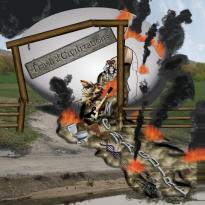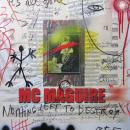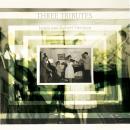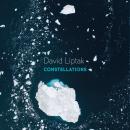Trash of Civilizations
Trash of Civilizations
Toronto, ONCanada
| Trash of CivilizationsiTunes Artist's PageiTunes Album Page | |||
|---|---|---|---|
| Song Title | Time | Price | |
| 1. | The Spawn of Abe | 27:59 | |
| 2. | Narcissus Auf Bali | 39:49 | |
Back with more maximalist, over the top, genre-defying, electro-medleys, MC Maguire's new aural behemoths are just in time for those addicted to serious sensory overload. Unhinged from a classical/electro-acoustic trajectory, Maguire's music has veered off into the ether of ethno/prog-alt rock/jazz/electronica. This po-mo hybrid usually consists of long concertos for live players with a dense, 300 track, multi-layered electronic accompaniment. The new CD is no exception, consisting of two double concertos featuring four uber-virtuosic musicians, blasting through mind-numbing machinations and/or tempos. The first tune, 'The Spawn of Abe'(28:11) jams on a mid-eastern flavoured, apocalyptic clash of the 3 monotheistic religions, while 'Narcissus auf Bali' (39:53) grooves out on the Greek myth of Narcissus and Echo romping through the jungles of Bali.
Trash of Civilizations is the follow up CD to the 2007 hit, Meta-Conspiracy.
MC Maguire is a Toronto-based composer and sound artist. This is his second CD for Innova. Trash of Civilization consists of two maximalist works of sound art. "The Spawn of Abe" for Bb clarinet, oboe, and computer is a double concerto portraying the apocalyptic clash between the three monotheist religions: Klezmer music and Arab elements, a plethora of sound samples, a well-controlled chaos, an overdose of information that will require several listens in order to peel the many layers of sounds and meanings. "Narcissus auf Bali" follows a similar template, this time based on the Greek myth of Narcissus, the vibraphone (Trevor Tureski) and marimba (Ryan Scott) evoking the soundworld of gamelan. This CD is stunning and loaded.
- Francois Couture, Monsieur Delire
This is an interesting album that doesn't sound like all the rest. The press release that accompanied this CD described the music as "ethno/prog-alt rock/jazz electronica"...and that is probably the best descriptive word string for this music. The disc is divided into two segments. "The Spawn of Abe," the first track, is over 28 minutes long and features only three players: Max Christie on clarinet, Mark Rogers on oboe, and MC Maguire on CPU. "Narcissus auf Bali," the second track, is even longer...clocking in at almost 40 minutes...and features the playing skills of Trevor Tureski (vibraphone),Ryan Scott (marimba), and (again) Maguire on CPU. Both of these pieces feature plenty of spontaneous improvisation...sorta like a cross between modern classical and modern jazz. All kinds of trippy sounds and voices bleed in and out of the mix...making for some rather strange and unpredictable listening. The second track is a truly wild ride indeed. Definitely an audio collage kind of experience here. Not recommended for folks needing and/or wanting simple hits to dance to. Mighty strange stuff...esoteric and strangely...hypnotic. We love it. Highly recommended. (Rating: 5+++)- dONW7, Babysue Top Picks
The CD perfectly reflects the postmodern approach in which he mixes ethnic music, jazz, electronic, pop, and contemporary classical music. The result is sophisticated.
- HisVoice Magazine
MC Maguire's insane and irritating work for Lee Su-Feh's Gecko Eats Fly (which won the French award for choreography in 1998) has resurfaced as Maguire's "Narcissus Auf Bali" on Innova Records. It still makes Su-Feh crazy, but I love it. Check it out. He's a Genius.
- Battery Opera
listening : MC Maguire, Narcissus auf Bali! 40 mins! AWESOME AWESOME AWESOME!
- Bill Solomon, twitter
Electroacoustic genre-clashing romps through a universe of sound blending live and organized sources from composer Maguire, works that have to be heard to be believed.
- Squidco
MC Maguire is basically a sampler artist who, somehow, managed to infiltrate the ranks of serious composers. Unlike what experimental electronica artists would come up with in such a set-up, Maguire churns out actual contemporary music, despite the fact that it is mostly made of urban, nature, and media-borne sounds, layers upon layers of bits of noise. It's an exciting feat --for acoustic instruments and computer, the latter assuming the role (but not the sound palette) of a symphony orchestra. When the computer gets the spotlight, you tend to process its maximalist output as sound art or collage art, but when the instruments are present, both their parts and the computer's have a distinct "contemporary classical" quality. "The Spawn of Abe is a an epic clash, replete with traditional music quotes in the instrumental parts, war-mongering samples, and large-scale confrontation. It is an exhilarating piece, reminiscent in part of the duo FURTS sample battles, framed in a "New Complexity" context. "Narcissus auf Bali" has a new sonic escalation at every turn. .very dense, hyperactive, demanding music.
- All Music Guide
"The sky is falling! The sky is falling!" That's the reaction Chicken Little would have upon hearing this disc. Others might exclaim, "Yikes!" or "Holy shit!" or "Oh no, the apocalypse!" And, in fact, this disc does sound like the end of the world: dense, loud, and unrelenting. These compositions pile sound upon sound, whether it be a spoken sample, folk riff, guitar feedback, explosion, or orchestral bombast, until the sources sardine each other like rush hour commuters. Some refer to this ambitious art as sound collage, but this phrase implies a minimum of overlapping edges. Instead, MC Maguire's Trash of Civilizations is more like a jumble, a repainted canvas with peeling layers, a wreck of girders and plastique. Listening is more than cinematic; it's sensory overload, an embarrassment of sonic riches shoehorned into a mere hour of music. Windows shatter, pool balls are broken, Godzilla roars: it's all here. This is probably not a good album to listen to on LSD, but it offers the same hallucinatory disorientation.
Why would you want this? Why would you want bombs and machine gun fire and minarets and choruses of crying babies? Why would you want crashing drums and chanting worshippers and improvised violin and vocoders? Some, admittedly, might not. The two tracks here are intensely musical, but follow no set pattern, offer no discernible beginning or end, pause not a second for reflection. As soon as one catches a snatch of melody adrift in the miasma and starts bobbing the head in empathetic recognition, the moment is over, interrupted, jarringly fused to the next. Whenever the pulse begins to pound in recognition of a pattern or overall scheme, the samples shift, or topple into live playing, and the blueprint is lost. The effect is like that of garbage pail punch (a popular fraternity drink in which every alcohol imaginable is poured into a trash can and masked with Kool-Aid) ..you don't know what's in it, but it packs a wallop.
So what exactly is going on here? The first track, "Spawn of Abe," pre-enacts a religious culture clash in which the world's top three monotheistic faiths, each of which traces its roots back to Abraham, go at it with each other. We get calls to Islamic prayer, Jewish folk tunes, and snippets of Christian hymn, overlaid by orchestral clashes, angry guitar feedback, military drills, and an overall sense of cacophony. The half-hour track begins and ends at full throttle, with no letup in between; it's a loud sandwich, with loud toppings, and it's breathtaking. There's no way to discern the intent of the composer, but one can easily speculate. Perhaps "Spawn of Abe" is meant to be satiric, mocking claims of exclusivity, or perhaps it is simply the musical equivalent of a little boy gleefully smashing all of his trucks together.
"Narcissus auf Bali" is a Balinese retelling of the story of Narcissus and Echo. The vibraphone takes center stage, while orchestral noises meander behind. Because this track features a primary instrument, the track seems at first to be more formulaic, but after ten minutes, a spoken sample changes the proceedings. We plummet into a world of birds and bongos, bazaar samples, ethnic singing and then, without warning, crunches, crashes, and cavings-in. When the vibraphone returns, its once-soothing sound turns suspect; we've been lulled before, but next time will not be as easily fooled. And so, we try not to be taken aback when we hear laser rays. At this point, why not?. The story of a god drowning because he is enamored with his own reflection carries much less weight than that of an apocalyptic vision, until the very end, laden with circus sounds, and fire, and screaming, and death.
One cannot help but admire the chutzpa required to carry such a project to fruition. At each juncture, given the choice, MC Maguire obviously went for faster, louder, more...
- Silent Ballet
In electronic music minimalist restraint and orderliness reigns supreme, even noise artists tend to favour clean, streamlined routes, so maximalist music of the kind MC Maguire makes is rare.... You could argue that such a hodge-podge resembles the melting pot of the 21st century world city... one comes away with the feeling after TV channel-surfing.
The two long pieces of 'Trash of Civilisations' offer contemporary takes on the concept of the double concerto: 'The Spawn of Abe' for Bflat clarinet and oboe (played by Max Christie and Mark Rogers respectively), 'Narcissus auf Bali' for vibraphone and marimba (Trevor Tureski and Ryan Scott), with Maguire doing the orchestra on 'CPU'. It's fitting that he lists CPU, as it's Central
Processing Unit, and not customary 'laptop', that Maguire plays: it's stuffed to bursting with samples and effects, piled on until it resembles a smeared, fizzing digital wash. Maguire sets up interesting dialogues for these trios to operate: 'The Spawn of Abe' sets to work on East-West cliches, and the woodwinds do a wondrous battle. 'Narcissus auf Bali' is initially more approachable, Tureski and Scott's percussion recalling post
- Reichians Tortoise in good moments...
- Cyclic Defrost
Genre jumping world shattering mind-bending sonic orgy. Jesus Christ, what a mess. I haven't heard this many styles thrown together in one song since Secret Chiefs 3: middle eastern, African tribal, 80s hair metal, daft punk, insanely epic Hollywood soundtracks...and that's just the first 6 minutes. Technically these are two modern classical pieces for clarinet/oboe (track 1) and vibraphone/marimba (track 2), but MC Maguire steals the show on the CPU, sampling and synthesizing his heart away and dropping a gazillion bombs on you fools. You don't have to play the tracks in their entirety ( you might lose a few years of life if you do) but you are required by law to play at least bits and pieces. Indescribably awesome stuff. 1. (28:11) Completely off the wall psycho epic soundtrack modern orchestra. If you're not sold by the first few bars, skip forward to about 2:10 to where the drums start galloping in and heaven comes down to rock out on earth. Time signatures change abruptly and without warning, and the sound palette reaches everywhere. Probably a thousand individual climaxes are hit in a half hour.
2. (39:53) Softer than the previous. A sort of underwater marimba dream where little marimba man is playing his little marimba...until he hits the wrong key and the entire universe explodes into a dynamic rumbling bliss fest where Navajo Indians battle Zeus and Achilles for global supremacy. And you haven't heard epic until you've made it pat the 30 minute mark... Absolutely nuts.
- Barbra Anne, Zookeeper
It is obvious from first to last that Maguire is a genius. His music is less working out of base materials than full frontal rhythmic and lyrical assault. He means to take over your sonic universe lock stock and space station, and succeeds. He holds you, captivated by his rolling rhythmic musings through one cultural reference after another, a klezmer band at a Chivas-soaked wedding, crisp radio static that leaves you wanting MORE crisp radio static! until your own sense of truth and aesthetics is formed into his. When his voice is heard at the end of the piece, playing lead character in a series of serial situations, a camping trip gone awry, a summer Barbeque gone sinister, we think more of a soul being cast into the fiery flames of hell having penned an unforgiveable series of sinful orgiastic montages. Hail to Maguire, King of all bombasts, slave to NONE!
- Dab Spector
With the hyperkinetic MC Maguire, we hear a work from 2007,"Narcissus auf Bali" for vibraphone, marimba and computer. "Narcissus auf Bali" is a kind of twist on the Greek myth of "Adriadne auf Naxos," but in MC Maguire has transformed the story of Narcissus who feverishly looking for the beautiful Echo in the Balinese jungle.
- Kaleidoscope
Listed in the 2009 Magazine albums of the year.
- ILXOR.COM Best Album of the Year 2009
MC Maguire's moniker sounds like that of a rapper, and there is indeed a sampler's mind-set at work in the Canadian postmodernist's brainy mishmashes. The composer's mission statement, per his website, is to save art from extinction via "reevaluation of high-art aesthetics in the light of popular culture's ubiquitous, formulaic infectiousness." The tone of the opening track on MC Maguire's latest, Trash of Civilizations, mirrors Girl Talk's ADHD cutting-and-pasting but replaces the whimsy with kaffiyeh-wearing grad-student pretension and moody video-game scores. The premise of "Spawn of Abe" unquestionably compels: A klezmer clarinet and a mizmar-like oboe traverse a soundscape of dusty Cairo streets, crowded Tel Aviv bars and chaotic battle scenes (all field recordings here). But early-'90s synth work renders several segments near-comic. Maguire is not to be dismissed, however. If "Abe" plays like a shroom-induced nightmare trek through the streets of Bethlehem, the album's second and final track, "Narcissus auf Bali," retains the composer's maximalist approach while remaining far more structurally coherent. Japanese pop lines feud with Balinese monkey vocalizations in this epic battle, which eloquently integrates solo vibraphone and marimba into a turbulent mix of East and West. It's not clear if, like the gaudy cover art, these half-hour pieces are intentionally ironic or just ambitious attempts by an overeager designer...- Doyle Armbrust, Time Out Chicago
MC Maguire is a composer who has been working since the 1970s. His works fuse elements of modern classical and pop culture. Trash of Civilizations presents two long-form pieces for live instruments and recorded sounds. The nearly half-hour opener, "The Spawn of Abe," features a Klezmer clarinet and an Arabic oboe prominently snaking through layers of rhythmic synth and sampled chaos. A thick soup full of singing and talking heads, cawing birds, machine guns, helicopters and the like are frequently punctured with shards of shattering glass. Although the liner notes don't list drums as an instrument, I can swear I hear some buried deep in the mix. The 40-minute "Narcissus auf Bali" replaces the woodwinds with percussion in the form of vibes, marimba and sampled gamelan. This piece pits nature's sublime harmony against urban industrial noise, and East vs. West as it visits more placid Oriental areas with somewhat homely melodies, and occasionally explodes with sudden complex, cartoon rhythms and big synth riffs that challenge Godzilla to a duel. Near the end, the piece gets really mellow and sparse, then, just when you think it's going to fizzle away, it builds up to a super-intense, dense frenzy with an abrupt ending, leaving nothing but the world's longest reverb tail. This music, which sounds like a blend of Iannis Xenakis, Biota and The Beatles "Revolution 9" on steroids, should go over big with any and all ADD victims in your household. I wonder what those folks who rioted at the premiere of Igor Stravinsky's The Rite of Spring would make of Trash of Civilizations? Would they be just as shocked at the fact that the cover art bears an uncanny resemblance to AMM's From a Strange Place after a nuclear meltdown? We may never know the answers to these questions! In any case, new music just got newer.
- Arcane Candy
There’s interesting stuff going on north of the border, especially when it comes to music which “mashes up” previous music to make new work. John Oswald got into serious trouble with his “Plunderphonics” some years back because he had the chutzpah to use Michael Jackson samples (and images), which aroused corporate fear and ire (and unleashed the lawyers). MC Maguire is probably smarter, in that he uses a huge range of samples blended in such a way as to create a fluctuating wall of sound where nothing is specifically identifiable. This is a report from the front of cutting-edge experiment. These two works (dating from 2008 and 1997, respectively) are each immense, rather like weather systems passing through, dumping rain and snow, with patches of sunlight, before they’ve run their course. They appear to have gone through different mutations before reaching this incarnation, where live instruments have been added to each to provide a sort of acoustic/real-time commentary. ( Nota bene : “cpu” is central processing unit, aka a computer, for those who may be scratching their heads.)This music will certainly not be for everyone. It revels in a sort of “info-overload” that, while representative of our era, goes against our usual ideals of concentrated, active listening. I think that for the 30- and 40-minute durations of each, one can go deep into the moment, but one will also have to withdraw in order to maintain a certain sanity. And that fluctuation in listening I think is natural to this music. …. Maguire seems to be rather listening to the world around him and just transcribing its multiplicity, even chaos. (Reading his notes, one discovers there’s a lot of architectural planning involved in what at first seems a completely capricious flow of sounds.)For some, this won’t be classical music, maybe not even music. (Based on the cover alone, they might avoid the disc, as it looks like a release from some sort of death-metal band.) In the end, for me that’s not a useful question.. In fact, I may not even like this music, but that also seems not very relevant to the experience. Rather, this feels like something very engaged with our time that teaches us something about ourselves and our culture. It’s fascinating, though perhaps a little like the way a car wreck beckons us to rubberneck. So I do recommend it, as an original, even disturbing, but creatively challenging experience for any listener.
- Robert Carl, Fanfare
Craving sensory overload? Seek out these two sprawling musical collages from Toronto-based composer MC Maguire. The CD booklet's concise, entertaining descriptions tell us much about his inspirations (from classical literature to pop culture via Ives, Carter and Britten), process (pitch structures, rhythmic modulations, movement parameters), and where his samples come from.
Maguire plays what he calls "CPU" on "The Spawn of Abe," a meditation about the divergence of Judaism, Islam and Christianity, with Max Christie on B-flat clarinet and Mark Rogers on oboe. Klezmer and Arabic flavors scamper or meander through a mash-up of electronic tones, collaged mullahs, priests and rabbis, battles, pop song snippets and crying babies, elbows-on-the-keyboard chords synched to breaking glass walls ... The music never settles, an accelerated weather map of war and politics and disputed landscape. Then, on "Narcissus auf Bali," Trevor Tureski on vibraphone and Ryan Scott on marimba join the CPU madness as Maguire plucks two figures from Greek mythology and turns them loose in an Asian jungle. Their cheesy B-movie dialogue punctuates a restless tug-of-war between Balinese pop, martial arts film scores, and thick electronic textures. Some of the movements last longer than the first piece, although the mallet instruments are reminiscent of the intellectual hot-dogging by Frank Zappa or Fred Frith. But if you resent that, this CD isn't for you.
MC Maguire demands that we stand in awe of these mammoth constructions. There's no other way if you want to spend a rewarding 68 minutes here.
- Alan K. Lipton, Expose
...with his near-epileptic maximalism, ...... using up almost up to 300 different layers of interaction and contrasts. There remains a clarity in building up the layers, even from completely different worlds, and in different rhythms, it is still controlled by the mind of the composer, the composition with classical underground directs, while all the elements tend to be behind or different, the compositional effect remains just that little bit stronger. Where the melodic compositional effects of computer composing could be tiring and limited is this edge of chaos which at the same time seems to overcome the compositional restrictions of melodic computer models, which makes the piece interesting. The second piece of nearly 40 minutes, “Narcissus auf Bali” is almost too much to handle. Again, the totality of interaction is near-chaotic and the maximalism often is too saturating up to a claustrophobic nervousness of an effect, with an overload of impulses that are but partly cooperative, so therefore this becomes narcotically epileptic. Too much is too much. Too much fragmentation is happening within a context that has no time to adapt but to collect, this is on the edge of a damaging collapse of the senses.- Gerald Van Waes, Psyche Music
The world as MC Maguire hears it, is what “Trash of Civilizations” is all about. It may not necessarily be the same world the listener inhabits, but a fascinating world it is. On CPU, Maguire manipulates, reverses and expands his electronic samples to create a wall of sound backdrop to live musical performances. ......Maguire's tough guy aural stance makes for powerful and eclectic listening. The Spawn of Abe Maguire heaps a bundle of samples from singing to Arab pop music to Klezmer bands to helicopters to amass a jungle of sound to accompany live performances by Max Christie on B flat clarinet and Mark Rogers on oboe.... Lots of excitement and lots of noise. Narcissus auf Bali is almost 40 minutes of mutating rhythms performed with perfection by Trevor Tureski on vibraphone and Ryan Scott on marimba.... the CPU layering encompasses a gamelan flavour. T. MC Maguire's music is really weird yet highly original and rewarding for those who dare to listen.
- Tiina Kiik, The Whole Note
“The Spawn of Abe,” the first of two tracks, is a 28-minute double concerto for clarinet (Max Christie on B-flat clarinet) and oboe (Mark Rogers), backed by a brilliant collage that evokes the sonic clashes of Charles Ives, updated to the contemporary Middle East. It’s a helter-skelter mix that explores, as Maguire writes in liner notes, the three major monotheistic religions with “incantations of mullahs, rabbis and priests, with the singing of cantors, muezzins and Gregorian Chant, Al-Quaeda ditties, a Bin Laden cameo, American-Jewish comedians, klezmer bands, Arab pop music, bars in Tel Aviv, the streets of Cairo, air raid sirens, jets, helicopters …
Inevitably, “The Spawn of Abe” spirals down the funnel of history toward another Holocaust, or maybe an ecumenical apocalypse. Few sounds are as instantly chilling as droning, WWII-era sirens. But after brief consideration, the music instead catapults into cosmic outer space — a little cheesy, perhaps, but satisfying in the context.
The other track, coming in at 40 minutes, is “Narcissus auf Bali,” on the Narcissus and Echo myth. It’s another double concerto of sorts, this time for vibraphone (Trevor Tureski) and marimba (Ryan Scott) backed by an “orchestra” of computer-processed sounds based on gamelan from the Indonesian island of Bali. It’s fun, manic, funny. The climax edges toward generic Hollywood, at which point this clever piece goes Roman Empire Epic on us...
...much of this album, the music is enthralling. The music brims with ideas and abundant pleasures. Pop and “world” music are as powerful an influence as 20th-century classical. Indeed, the creator might not deign to call the stuff “classical” at all.
- Pierre Ruhe, Arts Critic Atl




